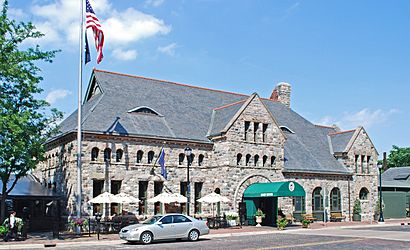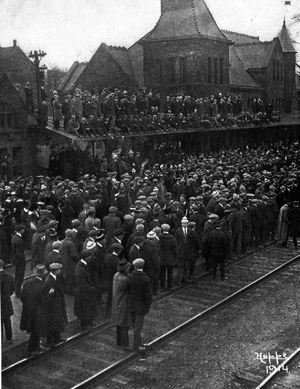Ann Arbor station (Michigan Central Railroad) facts for kids
Quick facts for kids
Ann Arbor
|
|||||||||||
|---|---|---|---|---|---|---|---|---|---|---|---|
 |
|||||||||||
| Location | 401 Depot Street, Ann Arbor, Washtenaw County, Michigan 48104 | ||||||||||
| Former services | |||||||||||
|
|||||||||||
|
Michigan Central Railroad Depot
|
|||||||||||
| Location | 401 Depot St., Ann Arbor, Michigan | ||||||||||
| Area | less than one acre | ||||||||||
| Built | 1886 | ||||||||||
| Built by | Gearing and Sons | ||||||||||
| Architect | Spier & Rohns, Frederick Spier | ||||||||||
| Architectural style | Richardsonian Romanesque | ||||||||||
| NRHP reference No. | 75000963 | ||||||||||
| Added to NRHP | March 10, 1975 | ||||||||||
The Ann Arbor station is a very old and important building in Ann Arbor, Michigan. It used to be a busy train station for the Michigan Central Railroad. Today, it is a popular restaurant called the Gandy Dancer. This building is so special that it was added to the National Register of Historic Places in 1975. It is officially known as the Michigan Central Railroad Depot.
How the Ann Arbor Train Station Began
The Michigan Central Railroad built its tracks through Ann Arbor in 1839. Soon, the railroad became super important for people traveling and for shipping goods. The train line reached the big city of Chicago by 1852.
In the late 1880s, the railroad started building new train stations, called depots. Each new depot had its own special design. For the Ann Arbor station, they chose Frederick Spier from a company in Detroit. The station was built by Gearing and Sons, also from Detroit. It was finished in 1886. Two smaller buildings were also built nearby. One was for sending packages, and the other was for luggage.
The Ann Arbor depot was very busy! In 1915, there were 13 train trips every day just between Detroit and Chicago. Plus, there were many shorter trips too. Lots of famous people passed through this station. These included presidents like Theodore Roosevelt, Grover Cleveland, William Howard Taft, and John F. Kennedy. Other famous visitors included William Jennings Bryan, Winston Churchill, and Richard Nixon.
Some famous passenger trains that stopped here were the Wolverine, the Chicago Mercury, and the Twilight Limited.
However, as more people started using cars, fewer people rode trains. This change happened quickly in the 1950s. By the 1960s, very few passengers were using the trains. In 1970, the railroad sold the station. A restaurant owner named Chuck Muer bought it. He turned the old station into the Gandy Dancer restaurant. In 1976, the restaurant grew bigger. It added a new section that connected the main station to the old luggage building.
What Does the Ann Arbor Station Look Like?
The Michigan Central Railroad Depot is built in a style called Richardsonian Romanesque. This means it looks strong and grand, like old Roman buildings. It is made entirely of rough, natural stone. These stones came from Four Mile Lake, which is between Chelsea and Dexter.
The building's special features, like its big arches and stone beams above windows, stand out. They use different colors and textures of stone to make them noticeable. The station has a tall, pointed roof with two small windows sticking out, called dormers. The east side of the building has large, rounded windows. The west side has regular windows with small round ones above them. The main entrance is a very large, round-topped arch. The doorway itself has been updated over the years.
Inside the original station, there was a fancy ticket booth. The ceiling and wood trim were made of beautiful red oak wood. The floors had French tiles, and there were colorful stained glass windows. A large fireplace made of terra cotta (a type of clay) was also a main feature. The only big change inside is a new balcony that was added.


